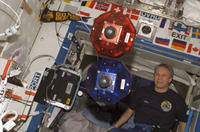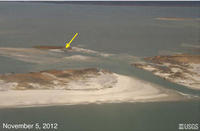-
DARPA’s first FANG Challenge begun yesterday

More than 700 participants, organized in 150 teams, yesterday begun collaboration to design the mobility and drivetrain systems of a next-generation, amphibious infantry fighting vehicle. The goal of the competition is to compress the design-to-production time of a complex defense system by up to a factor of five.
-
-
Better screening for bacteria for safer food

There are around 5.4 million cases of food-borne gastroenteritis in Australia every year. Of these cases, it is estimated that around 200,000 are associated with the bacteria Campylobacter jejuni and Campylobacter coli. Chicken meat and other foods will be able to be screened for bacteria even faster and more effectively than ever, thanks to breakthrough nanobiotechnology research.
-
-
Global warming threatens U.K. diet
The number of days with temperatures over 32 degrees C has more than doubled in some parts of France over the last fifty years. Many other land areas show similar increases. By the 2020s, temperatures over 32 degrees C could occur over large areas of France where previously they were uncommon. Maize yields are reduced significantly for each day with temperatures over around 32 degrees Celsius. The United Kingdom imports more maize from France than anywhere else in the world, and declining crop yields in France mean that U.K. consumers will have to pay more for maize-based foods, or change their diets.
-
-
Drought, heat turn hundreds of U.S. counties into disaster areas

The U.S. Agriculture Department (USDA) last week said that drought conditions and heat necessitated designating 597 counties in fourteen states as primary natural disaster areas. The affected counties have suffered severe drought for eight consecutive weeks, which qualified them for the automatic designation. 2012 had been the hottest year on record for the continental United States: the year’s average temperature of 55.3 degrees Fahrenheit across the Lower 48, which was more than 3.2 degrees warmer than the average for the twentieth century.
-
-
Neutralizing the effects of lethal chemical agents
Organophosphorus agents (OPs) are used both in farm pesticides, and by terrorists and rogue states. About 200,000 people die each year across the world from organophosphorus agents (OP) poisoning, through occupational exposure, unintentional use, and misuse, mostly in developing countries like India, Pakistan, and Sri Lanka and through deliberate terrorist activities. OPs include compounds like Tabun, which was developed in 1936 by German scientists during the Second World War, Sarin, Soman, Cyclosarin, VX, and VR. Researchers develop an enzyme treatment which could neutralize the effects of OPs.
-
-
Tiny helpers: Atom-thick flakes help clean up radioactive waste, fracking sites

Graphene oxide has a remarkable ability quickly to remove radioactive material from contaminated water. Researchers determined that microscopic, atom-thick flakes of graphene oxide bind quickly to natural and human-made radionuclides and condense them into solids. The discovery could be a boon in the cleanup of contaminated sites like the Fukushima nuclear plants, and it could also cut the cost of hydraulic fracturing (“fracking”) for oil and gas recovery and help reboot American mining of rare earth metals.
-
-
Catching up: Indian and Chinese companies at the forefront of innovation
In a few short years, the Chinese and Indian share of the world’s research and development centers has increased from 8 to 18 percent. A new study says that India and China invest more than the West in organizational innovation, that is, the implementation of a company structure that creates a favorable climate for new inventions.
-
-
Fourth annual student robotic challenge held today

NASA is joining the Defense Advanced Research Projects Agency (DARPA), the Massachusetts Institute of Technology (MIT), and high school student teams from the United States and abroad for the fourth annual Zero Robotics SPHERES Challenge today, 11 January
-
-
Students overlooking more effective methods
Some of the most popular study strategies — such as highlighting and even rereading – do not show much promise for improving student learning, according to a new report; while the ten learning techniques examined vary widely in effectiveness, two strategies — practice testing and distributed practice — made the grade, receiving the highest overall utility rating
-
-
Students develop low-cost water filtering system for African nation
Every year, 3.4 million people die from lack of access to fresh water globally; in East Africa, daily routines include women venturing miles to secure fresh water and bearing the heavy weight of water containers to secure less-than-desirable water; in an effort to bring fresh water to rural Kenyans, Penn State’s School of International Affairs (SIA) students have developed a ceramic water filtration system for parts of the sub Saharan African nation
-
-
Instant DNA analysis worries privacy advocates
In the past, it took weeks to analyze a person’s DNA, but with new technology it can take less than a day, and in most cases less than two hours; Rapid DNA analyzers can process a DN sample in less than ninety minutes; these machines, the size of a household printer, are now being marketed to local, state, and federal law enforcement agencies around the country; privacy advocates worry
-
-
Laser weapon tracks, destroys drones, mortar rounds in mid-flight
A 50kW high energy laser (HEL) weapon technology demonstrator successfully passed demanding tests in Switzerland; in the first test, a massive, 15mm-thick steel girder was cut through from a distance of 1,000 meters; even more impressively, the HEL shot down several nose-diving target drones at a range of two kilometers; the drones were flying at speeds over 50 meters a second, but the system’s radar had no trouble picking up the incoming unmanned aerial vehicles at a distance of three kilometers, before they were destroyed by the laser beam at a 2-km range; the HEL also tracked and destroyed a steel ball measuring 82 mm in diameter and travelling at approximately 50 m/sec – replicating a mortar round – in mid-air
-
-
Shoring up Long Island’s natural shore defenses against future storms

Sand and other coarse-grained sediments are vital to the naturally occurring barrier systems which dissipate storm surges, protect coastal residences, and shelter biologically diverse estuaries and ecosystems; a team of researchers is conducting marine geophysical surveys of the seafloor and shallow subsurface to assess the health of the offshore barrier system which protects the New York Harbor and southwestern Long Island region against damage from future storms
-
-
Fish zapping: shocking Asian carp out of Midwest waters not feasible
The several species known as Asian carp are not native to U.S. waterways but have been found in rivers throughout the Midwest; these fish are competing with native species for food and altering ecosystems; they are also dangerous to boaters and other river users since Asian carp can weigh up to sixty pounds and are known to jump out of the water during even minor disturbances; scientists had hoped to modify or expand low-voltage electrical barriers like those used around Chicago waterways to direct Asian carp from particular areas, but found that the level of electricity needed would be far too high
-
-
New York State power plants showing their age

New York State could face power plant closings in the near future as a result of updated environmental regulations and the fact that plants in the state are outdated and inefficient; a recent report concluded that New York’s coal and nuclear power plants, as well as steam and turbine plants that run on oil or gas, are on average older than others around the country
-
More headlines
The long view
Encryption Breakthrough Lays Groundwork for Privacy-Preserving AI Models
In an era where data privacy concerns loom large, a new approach in artificial intelligence (AI) could reshape how sensitive information is processed. New AI framework enables secure neural network computation without sacrificing accuracy.
AI-Controlled Fighter Jets May Be Closer Than We Think — and Would Change the Face of Warfare
Could we be on the verge of an era where fighter jets take flight without pilots – and are controlled by artificial intelligence (AI)? US R Adm Michael Donnelly recently said that an upcoming combat jet could be the navy’s last one with a pilot in the cockpit.
The Potential Impact of Seabed Mining on Critical Mineral Supply Chains and Global Geopolitics
The potential emergence of a seabed mining industry has important ramifications for the diversification of critical mineral supply chains, revenues for developing nations with substantial terrestrial mining sectors, and global geopolitics.
AI and the Future of the U.S. Electric Grid
Despite its age, the U.S. electric grid remains one of the great workhorses of modern life. Whether it can maintain that performance over the next few years may determine how well the U.S. competes in an AI-driven world.
Using Liquid Air for Grid-Scale Energy Storage
New research finds liquid air energy storage could be the lowest-cost option for ensuring a continuous power supply on a future grid dominated by carbon-free but intermittent sources of electricity.
Enhanced Geothermal Systems: A Promising Source of Round-the-Clock Energy
With its capacity to provide 24/7 power, many are warming up to the prospect of geothermal energy. Scientists are currently working to advance human-made reservoirs in Earth’s deep subsurface to stimulate the activity that exists within natural geothermal systems.
